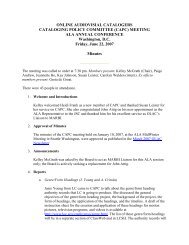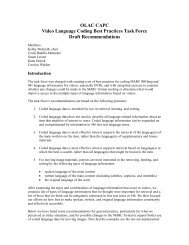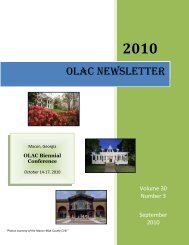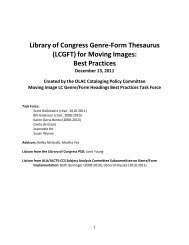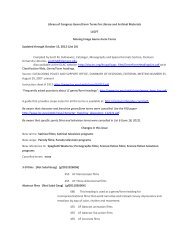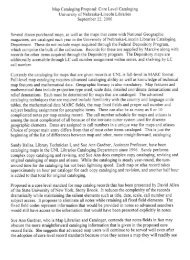see workshop handouts - OLAC
see workshop handouts - OLAC
see workshop handouts - OLAC
You also want an ePaper? Increase the reach of your titles
YUMPU automatically turns print PDFs into web optimized ePapers that Google loves.
H o w to Date a R o a d Map<br />
Most maps are easily dated either by a prominent date on the<br />
cover or in the map legend. But there are 6till many maps on which<br />
no date can be found. Rand McNally and H.M. Cou6ha use a code hidden<br />
on a map margin to date their maps. These codes are explained below.<br />
General Drafting has not used euch a code, yet they have varied<br />
their dating and an explanation is given for them as well. For all<br />
Other map publisher6, either their code is not known, if they have<br />
one, or their date is easily read,<br />
When a map is undated, dates mu6t be determined by comparing the<br />
map to a map of known date. Many companies also changed their covers<br />
each year, 60 that once a particular cover design is dated, other<br />
maps of the same design are considerced as the Same date. But this<br />
method of comparing covers of like design is prone to possible error,<br />
so care should be taken when using this method.<br />
first appeared in 1926 but do not show on most maps Until 1927. For<br />
older maps this is a helpful guide. Many states numbered their,roads<br />
well before 1926.<br />
The detailed tables which are included in this catalog may also<br />
be used to some degree to date a map. Most companies have used<br />
different publisher6 over the year6 a6 well as both expanding and<br />
contracting the territory they Serve, thus helping to limit<br />
possibilities.<br />
Rand McNally Map Date Codes<br />
Over the years Rand appear6 to have used a number of "systems"<br />
to date their maps. All variations may not be explained here -- but<br />
most maps should still be able to be dated. One big exception, in<br />
the 20's some Rand maps have no letter6 or numbers at all and these<br />
must be dated by comparing to known dated maps.<br />
First, Rand used a simple letter code, A for 1919, B for 1920,<br />
through Z in 1944. However, some year6 prior to 1944 number6 began<br />
to appear after the letter. If the set of number6 has 4 digits, the<br />
first 2 digits indicate the year the base map was drafted while the<br />
second 2 digits either indicate the year the first Rand map was made<br />
of the area (the original base) or simply a code for the area<br />
covered. The latter <strong>see</strong>ms more likely except that it limits Rand to<br />
100 areas. If only 2 digit6 exist after the letter, they <strong>see</strong>m to be<br />
a code for. the area.<br />
Now after 1944 the letter was replaced by a 1 or 2 digit year<br />
preceding the above series of digit6 and often separated by a hyphen-<br />
From 1945 to 1965 only the last digit of the year was u6ed. To<br />
distinguish 1945 from 1955 from 1965 generally requires common<br />
sense--look at the census date if given, interstate highways, etc.<br />
From 1966 to present, the last 2 digits of the year are used.<br />
At some point the series of 4 digits was increased to 6 digits<br />
although .this now has been discontinued. It is thought these extra<br />
digit6 indicate the number of printings and would change for each Oil<br />
company, etc. Lastly, still one or two more digits were added after<br />
the above series of digits and are separated by a hyphen. These<br />
represent the number of edition6 (possibly updates) to the base map<br />
thru the current map.<br />
Examples:<br />
Z 4424 The Z indicates a 1944 printing, the 44 shows that the<br />
base map was newly drawn this year, the 24 either shows the original<br />
base map was drawn in 1924 or simply a code signifying the area



